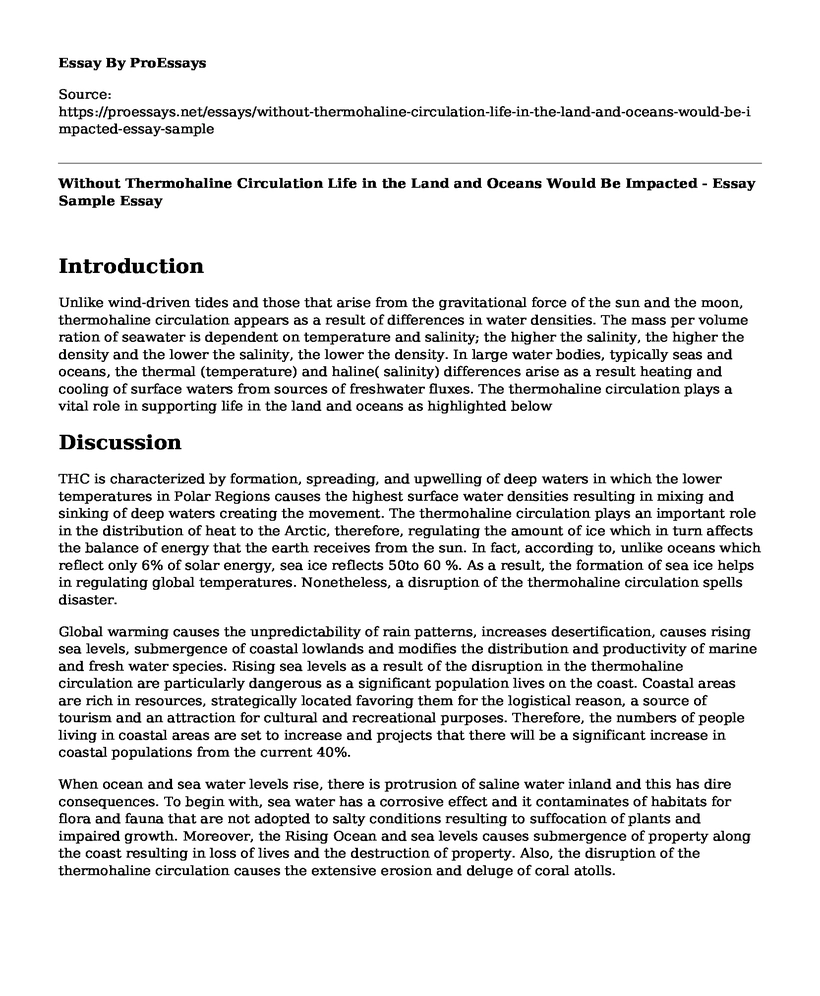Introduction
Unlike wind-driven tides and those that arise from the gravitational force of the sun and the moon, thermohaline circulation appears as a result of differences in water densities. The mass per volume ration of seawater is dependent on temperature and salinity; the higher the salinity, the higher the density and the lower the salinity, the lower the density. In large water bodies, typically seas and oceans, the thermal (temperature) and haline( salinity) differences arise as a result heating and cooling of surface waters from sources of freshwater fluxes. The thermohaline circulation plays a vital role in supporting life in the land and oceans as highlighted below
Discussion
THC is characterized by formation, spreading, and upwelling of deep waters in which the lower temperatures in Polar Regions causes the highest surface water densities resulting in mixing and sinking of deep waters creating the movement. The thermohaline circulation plays an important role in the distribution of heat to the Arctic, therefore, regulating the amount of ice which in turn affects the balance of energy that the earth receives from the sun. In fact, according to, unlike oceans which reflect only 6% of solar energy, sea ice reflects 50to 60 %. As a result, the formation of sea ice helps in regulating global temperatures. Nonetheless, a disruption of the thermohaline circulation spells disaster.
Global warming causes the unpredictability of rain patterns, increases desertification, causes rising sea levels, submergence of coastal lowlands and modifies the distribution and productivity of marine and fresh water species. Rising sea levels as a result of the disruption in the thermohaline circulation are particularly dangerous as a significant population lives on the coast. Coastal areas are rich in resources, strategically located favoring them for the logistical reason, a source of tourism and an attraction for cultural and recreational purposes. Therefore, the numbers of people living in coastal areas are set to increase and projects that there will be a significant increase in coastal populations from the current 40%.
When ocean and sea water levels rise, there is protrusion of saline water inland and this has dire consequences. To begin with, sea water has a corrosive effect and it contaminates of habitats for flora and fauna that are not adopted to salty conditions resulting to suffocation of plants and impaired growth. Moreover, the Rising Ocean and sea levels causes submergence of property along the coast resulting in loss of lives and the destruction of property. Also, the disruption of the thermohaline circulation causes the extensive erosion and deluge of coral atolls.
Conclusion
It is clear that the thermohaline circulation plays regulates global temperatures whose occurrence alters the supply of heat to Arctic regions, therefore, controlling the amount of ice which in turn affects the balance of energy that the earth receives from the sun.
Cite this page
Without Thermohaline Circulation Life in the Land and Oceans Would Be Impacted - Essay Sample. (2022, Nov 30). Retrieved from https://proessays.net/essays/without-thermohaline-circulation-life-in-the-land-and-oceans-would-be-impacted-essay-sample
If you are the original author of this essay and no longer wish to have it published on the ProEssays website, please click below to request its removal:
- Desalination vs. Waste Water Re-Cycling
- Annotated Bibliography on Technology and Environment
- Sampling Water Outlets Essay
- Essay Example on 4 Global Threats: Globalization, Climate Change, War, Tech
- Exploring the National Park: A Memorable Adventure - Essay Sample
- Global Warming: The Devastating Effects of Climate Change - Essay Sample
- Lead Contamination: Impacts on Health, Environment, and Communities - Essay Sample







